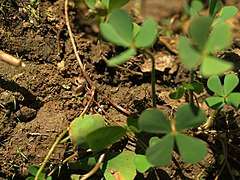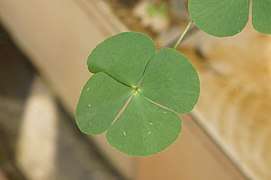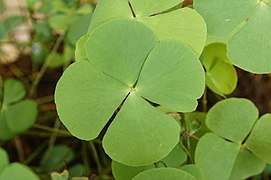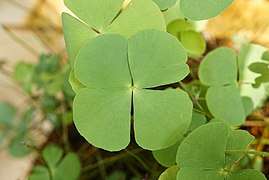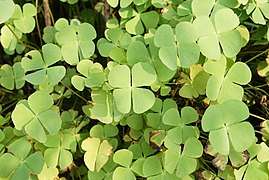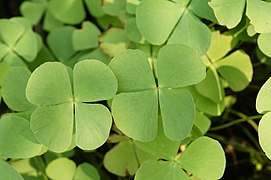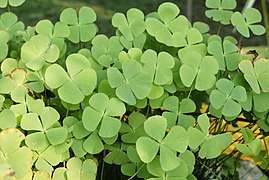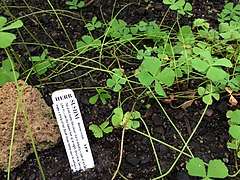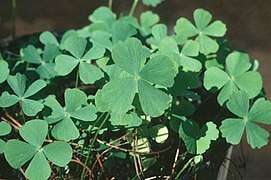Marsilea minuta
Marsilea minuta, or dwarf waterclover is a species of aquatic fern in the family Marsileaceae. It is not to be confused with Marsilea minuta E.Fourn. 1880, which is a synonym for Marsilea vestita.[4] Other common names include gelid waterklawer, small water clover,[1] airy pepperwort, and pepperwort,[7] though the lattermost also applies to plants in the genus Lepidium. In French it is called marsilea à quatre feuilles (literally "four-leafed marsilea")[7] and petite marsilée (literally "little Marsilea"),[1] the latter appearing to be a calque with the Latin botanical name. In Chinese it is 南国田字草 (nan guo tian zi cao),[8] literally "southern field word grass," referencing the similarity of the leaflet shape to the Chinese character for "field." The Koch Rajbongshi people and Garo people call it shusni shak.[9] It is called 'শুশনি শাক' ('shushni shak') in Bengali. In parts of India it can be called sunisanakka[10] In Indonesian it is semanggi (literally "clover"),[7] but this name also applies to Marsilea crenata. In Japanese it is nangokudenjiso and in Thai it is phakwaen.[7] In Malaysian it is tapak itek (literally "site duck").[7] In the Philippines it is kaya-kayapuan (literally "so crowded").[7]
| Marsilea minuta | |
|---|---|
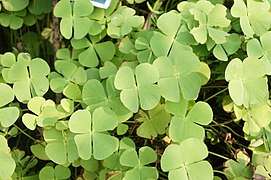 | |
| Marsilea minuta | |
| Scientific classification | |
| Kingdom: | Plantae |
| Clade: | Tracheophytes |
| Class: | Polypodiopsida |
| Order: | Salviniales |
| Family: | Marsileaceae |
| Genus: | Marsilea |
| Species: | M. minuta |
| Binomial name | |
| Marsilea minuta | |
| Subspecies | |
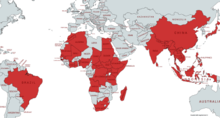 | |
| Native range of Marsilea minuta[1][4] | |
| Synonyms[2] | |
|
List
| |
Description
M. minuta has a strongly variable appearance,[5] which often leads to confusion with closely related species. In the water the plant is creeping and spreading, while on land it can appear cushion-like.[5] It typically is perennial but sometimes appears annual. It is a tenagophyte, with the juvenile growing submerged and the adult typically terrestrial.[5]
It has a light brown to green rhizome that is 0.4-0.8mm thick with short tan hairs at the ends and internodal roots.[4] The land leaves are on erect, terete, 5–13 cm long petioles.[4] The leaflets are 0.8-1.7 cm by 1.2–2 cm, mostly glabrous, cuneate or flabellate.[4] The leaves in water are typically not floating, but emergent from the water.[4] Fertile leaves are produced on land with up to four sporocarps each at penduncles near the base of the petiole.[4] It has a small sporocarp that is 2.6-4.1mm long, 2.4-3.1mm wide, and 1.3-1.7mm thick.[4][11] The sporocarp has a superior tooth at the apex of the stalk and an inferior tooth at the base.[12][5] The sporocarp has a conspicuous 1.5-2.2mm long raphe,[4][12] about ⅔ the length of the sporocarp and semi-terete.[5] Unlike a few Marsilea species, M. minuta sporocarps mature above ground.[12]
| Ploidy | diploid[13] |
|---|---|
| Number of chromosomes | 40[13] |
Taxonomy
M. minuta is thought to be closely related to Marsilea quadrifolia.[4] Molecular phylogenetic analysis of the genus Marsilea puts both in a widespread Old World subgroup also called "Marsilea" along with M. angustifolia, M. drummondii, M. crenata, and M. fadeniana and indicating that M. crenata is actually a synonym of M. minuta.[12][7]
| Marsilea subgroup |
| ||||||||||||||||||||||||||||||||||||||||||||||||
Habitat and ecology
Marsilea minuta can grow from sea level up to 1,950m in elevation[1] in ponds and other shallow water.[8] It can grow in fresh water or brackish water in clay or sandy soil.[4] The plant can develop into large colonies, and can be weedy.[4][11] Some of its preferred habitat is being lost to agriculture but as it readily grows in Paddy fields, drainage ditches, and other marginal areas its overall population is stable.[1] It has the potential to be invasive and dispersal through aquarium trade and other human means should be limited.[7]
It is a native plant in the following countries:[1]
- Algeria
- Angola
- Bangladesh
- Benin
- Bhutan
- Brazil[4]
- Burundi
- Cambodia
- Central African Republic
- Chad
- China
- Comoros
- Democratic Republic of the Congo
- Côte d'Ivoire
- Egypt
- Ethiopia
- Ghana
- Guinea-Bissau
- India
- Indonesia
- Japan
- Kenya
- Laos
- Madagascar
- Malaysia
- Maldives
- Mali
- Mauritania
- Morocco
- Myanmar
- Nepal
- Nigeria
- Philippines
- Réunion
- Senegal
- Singapore
- Somalia
- South Africa
- South Sudan
- Sri Lanka
- Sudan
- Tanzania
- Thailand
- Trinidad and Tobago[4]
- Uganda
- Vietnam
The leaves and sporocarps of M. minuta are eaten by many waterfowl species, and the intact sporocarps pass through undigested to be spread to new areas.[7] Elophila responsalis also feeds on the leaves, but is not thought to do much damage to the plant.[7]
The plant is susceptible to herbicides such as bensulfuron-methyl. cinosulfuron, 2,4-Dichlorophenoxyacetic acid, oxyfluorfen, and paraquat.[7] Otherwise it can tolerate high levels of organic pollution.[5]
Uses
It is eaten in India, Sri Lanka,[14] and in Bangladesh.[9] In China it is used as forage.[8] It has a raw protein content of 3.3%.[14]
The plant is used traditionally in China for edema, skin injuries, snakebite, and inflammation.[8] In Mymensingh District it is traditionally used to treat cough, headache, hypertension, sleep disorders, and respiratory diseases.[9] It is combined with Nardostachys jatamansi and after development by Asima Chatterjee[15] sold as an ayurvedic treatment for epilepsy called "Ayush-56."[10] However, Ayush-56 does not show encouraging results in treating the disease.[16] It is also used as a phytoremediator of arsenic while growing with rice plants.[17][18]
Gallery
References
- Beentje, H.J. (2017). "Marsilea minuta (Dwarf Water Clover, Gelid Waterklawer, Small Water Clover)". IUCN Red List of Threatened Species. 2017. doi:10.2305/IUCN.UK.2017-1.RLTS.T164326A84291386.en.
- "Marsilea minuta L. — The Plant List". The Plant List. 2012. Retrieved 23 August 2017.
- Marsilea minuta L. in GBIF Secretariat (2016). GBIF Backbone Taxonomy. Checklist Dataset https://doi.org/10.15468/39omei https://www.gbif.org/species/5274876 accessed via GBIF.org on 2017-09-20.
- Johnson, David M. (25 June 1986). Systematics of the New World Species of Marsilea (Marsileaceae). Systematic Botany Monographs. 11. Ann Arbor, MI: The American Society of Plant Taxonomists. pp. 39–40, 51, 63. doi:10.2307/25027626. ISBN 978-0912861111. ISSN 0737-8211. JSTOR 25027626. OCLC 13455360.
- Cook, Christopher D. K. (28 March 1996). "Cyperaceae". Aquatic and Wetland Plants of India: a reference book and identification manual for the vascular plants found in permanent or seasonal fresh water in the subcontinent of India south of the Himalayas. New York, NY: Oxford University Press. p. 105. ISBN 9780198548218. OCLC 32968513.
- Marsilea minuta L. in GBIF Secretariat (2016). GBIF Backbone Taxonomy. Checklist Dataset https://doi.org/10.15468/39omei accessed via GBIF.org on 2017-09-17
- "Marsilea minuta (pepperwort)". Invasive Species Compendium. Wallingford, UK: CAB International. 15 May 2008. Retrieved 29 August 2017.
- Lin, Y. X.; Johnson, D. M. (6 June 2013). Wu, Z. Y.; Raven, P. H.; Hong, D. Y. (eds.). "Marsileaceae" (PDF). Flora of China. 2–3: 123–124. Retrieved 25 August 2017.
- Sarker, Sujan Kumer; Hossain, A.B.M. Enayet (June 2009). "Pteridophytes of Greater Mymensingh District of Bangladesh used as Vegetables and Medicines". Bangladesh Journal of Plant Taxonomy. 16 (1): 54. CiteSeerX 10.1.1.606.3195. doi:10.3329/bjpt.v16i1.2746. ISSN 2224-7297.
- Krishnamoorthy, Ennapadam S.; Shorvon, Simon; Schachter, Steven; Misra, Vivek, eds. (6 April 2017). "34 Ayurveda and Yoga in the Management of Epilepsy". Epilepsy: A Global Approach. Cambridge University Press. p. 160. doi:10.1017/9781139547918. ISBN 9781108232159. Retrieved 29 August 2017.
- Schelpe, E. A. C. L. E. (1970). "eFloras Results For Marsilea minuta". Flora Zambesiaca. Royal Botanic Gardens, Kew. Retrieved 29 August 2017.
- Nagalingum, Nathalie S.; Schneider, Harald; Pryer, Kathleen M. (2007). "Molecular Phylogenetic Relationships and Morphological Evolution in the Heterosporous Fern Genus Marsilea". Systematic Botany. 32 (1): 16–25. doi:10.1600/036364407780360256. ISSN 1548-2324.
- Srivastava, R. B. (1985). "Ferns of the Indo-Nepal border". Proceedings of the Royal Society of Edinburgh, Section B. 86: 471. doi:10.1017/S0269727000008770. ISSN 0269-7270. OCLC 5549574398.
23. M. minuta L. 40 20 2.9-4.6 Diploid
- Terra, G.J.A. (1966). "IIID Ferns and Related Plants". Tropical vegetables: vegetable growing in the tropics and subtropics especially of indigenous vegetables. Communication. 54e (1st ed.). Amsterdam: Koninklijk Instituut voor de Tropen. p. 57. OCLC 9027279.
Marsilea minuta L. (Marsileaceae) I Ce (3.3%)
- Basak, Swati (May 2015). "Women, Science, Education And Empowerment: Asima Chatterjee, The Genius Lady" (PDF). IMPACT: International Journal of Research in Humanities, Arts and Literature. 3 (5): 133–138.
- Tripathi, M; Maheshwari, MC; Jain, S; Padma, MV (2000). "Ayurvedic Medicine and Epilepsy" (PDF). Neurology Journal of Southeast Asia. 5: 1–4. Retrieved 29 August 2017.
- Hassi, Ummehani; Hossain, Md. Tawhid; Huq, S. M. Imamul (2017-10-10). "Mitigating arsenic contamination in rice plants with an aquatic fern, Marsilea minuta". Environmental Monitoring and Assessment. 189 (11): 550. doi:10.1007/s10661-017-6270-2. ISSN 0167-6369. PMID 29018967.
- Hassi, U; Hossain, MT; Huq, SMI (2018-07-08). "Nitrogen, phosphorus and potassium status of rice co-planted with a novel phytoremediator, Marsilea minuta L." Bangladesh Journal of Agricultural Research. 43 (2): 211–218. doi:10.3329/bjar.v43i2.37326. ISSN 2408-8293.
External links
- Marsilea minuta at iNaturalist



